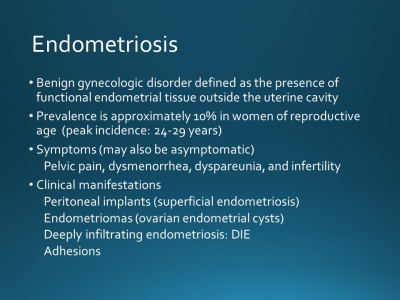Sunrise Session
Benign Pelvic Diseases
Session Topic: Educational Q&A: Body Sunrise
Session Sub-Topic: Benign Pelvic Diseases
Sunrise Session
ORGANIZERS: Reiko Woodhams, Daniel Margolis, Johannes Heverhagen, Mustafa Shadi Bashir
| Tuesday Parallel 3 Live Q&A | Tuesday, 11 August 2020, 15:15 - 16:00 UTC | Moderators: Aki Kido & Victoria Chernyak |
Skill Level: Basic
Session Number: S-Tu-01
Overview
MRI is a key technique for assessing pelvic pathology. It also plays a critical role in diagnosing benign diseases, outlining extension of disease, and differentiation from malignant disease. MRI significantly contributes to determination of patient's management.
Target Audience
Clinical radiologists and Ph.D. scientists interested in pelvic imaging.
Educational Objectives
As a result of attending this course, participants should be able to:
- Articulate MR imaging anatomy of pelvic organs;
- Describe pathology and etiology of endometriosis and PID;
- Describe pathology and etiology of benign bowel disease in the pelvis;
- Explain appropriate scan protocol;
- Recognize MRI features of endometriosis and PID;
- Recognize MRI features of benign bowel disease and its complications; and
- Differentiate benign pelvic diseases from malignancies.
| Benign Bowel Disease in the Pelvis
Verena Obmann
|
||
 |
MR Imaging of Endometriosis: What Radiologists Should Know
Yuko IRAHA
Endometriosis, a common gynecologic disorder affecting approximately 10% of women of reproductive age, is defined as the extra-uterine presence of functional endometrial tissue. The most common symptoms are pelvic pain and infertility, though they do not always correlate with disease severity. Endometriosis typically affects the ovaries, uterosacral ligaments, peritoneum, fallopian tubes, urinary tract, and rectosigmoid colon. Though definite diagnosis requires laparoscopy, preoperative identification of endometriosis and its extension is crucial. Magnetic resonance imaging (MRI) is an excellent imaging modality for diagnosis and treatment planning. Radiologists should be familiar with the MRI features of endometriosis and its wide spectrum of manifestations.
|
|

 Back to Program-at-a-Glance
Back to Program-at-a-Glance Watch the Video
Watch the Video Back to Top
Back to Top